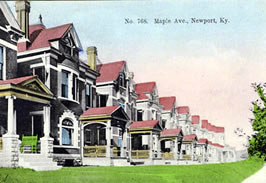 |
||||||





"The legal framework in each state must be carefully considered before
a local preservation ordinance is adopted…The case law interpreting
that legal basis also varies somewhat from state to state. It, too, must
be researched and considered to determine the constitutional basis of
historic preservation in each state and the substantive and procedural
points that must be addressed in a preservation ordinance…"
Richard J. Roddewig, Preparing a Historic Preservation Ordinance, American
Planning Association, 1983.
Legal basis in land-use regulations
Because local historic districts have direct impacts on private property, the question of their legal basis and constitutionality often arises. Historic district controls exist within the broader context of land use regulations that have been extensively reviewed and examined by the courts. The basic origin for historic preservation controls lies with the development of municipal land use and zoning controls in the early twentieth century. In 1926, the U.S. Supreme Court decision in Village of Euclid v. Amber Realty Co, 272 U.S. 365 (1926), upheld the constitutionality of local zoning ordinances and established the ability of municipalities to regulate land use through the exercise of their police powers.
As land use controls evolved, they eventually began to encompass aesthetic considerations and the desire of communities to protect and preserve the character of their historic and architectural resources. In 1954, the U.S. Supreme Court affirmed the constitutionality of "aesthetic" zoning in the case of Berman v. Parker, 348 U.S. 26 (1954) (USSC+). With the development of historic district controls, state judicial opinions supported the use of such regulation as a valid exercise of the state's power to promote the general welfare.
It was not until 1978, when the U.S. Supreme Court decided Penn Central Transportation v. City of New York, 438 U.S. 104 (1978), that the constitutionality of local controls to further historic preservation was affirmed. In this landmark case, the Court considered whether historic preservation controls constituted a taking in violation of the Constitution's Fifth Amendment, which provides that private property shall not be taken for public use without just compensation. The Court found that historic preservation is a valid public purpose, and that the City of New York's landmark restrictions on Grand Central Station did not constitute a "taking," because the controls did not prevent a reasonable economic use of the property.
Although the courts have recognized the basic constitutionality of local historic preservation controls, they are still subject to legal challenge, often involving the claim of a taking. However, unless the regulation is found not to advance a legitimate public interest, or the restrictions on designated property are so severe as to deprive the owner of any reasonable economic use, historic preservation controls will remain solidly within the broad spectrum of constitutional land use controls.
---------------------------------
Excerpt from A Guidebook for Historic District Commissions, Massachusetts Historical Commission, 1998.